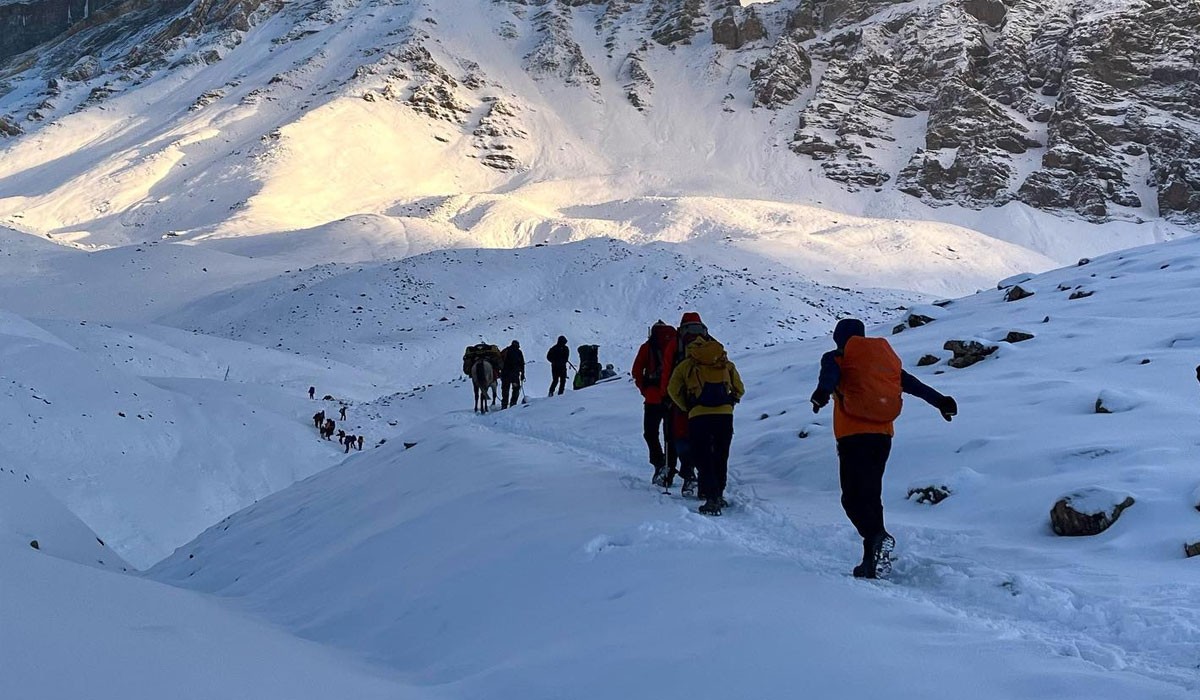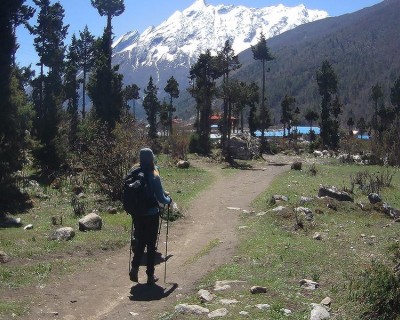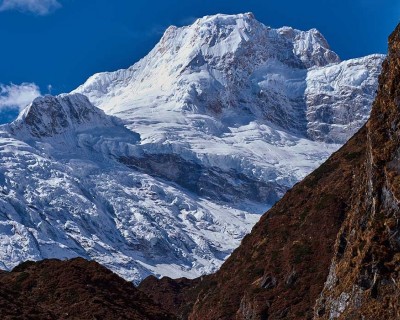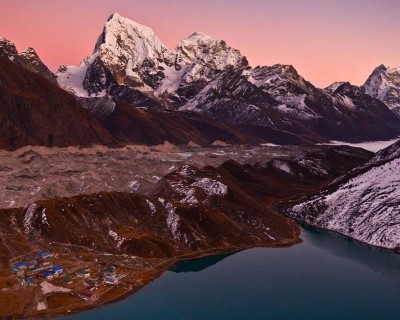Annapurna Circuit Trek in January
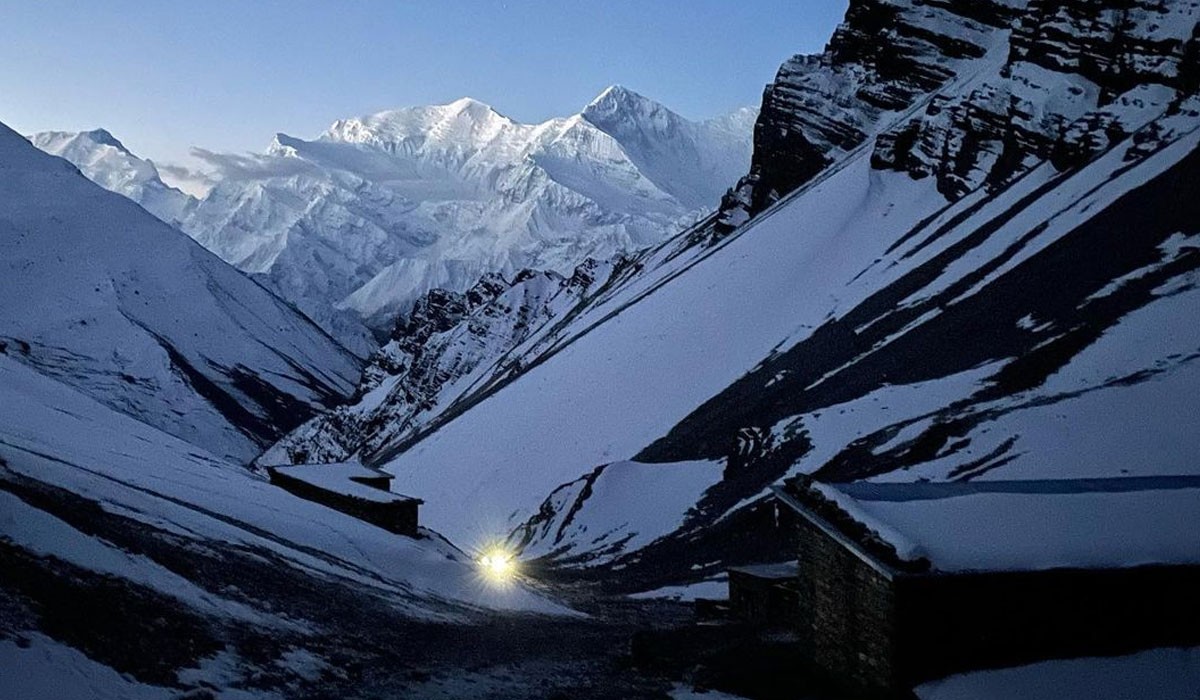
January is considered the peak of the winter season in Nepal; starting from December, the winter climatic conditions of the Himalayas reach their peak during January. However, it is also the best time to enjoy the magnificent landscape of the region covered with the pristine sparkling snow.
The temperature of the Annapurna region averages around 5°C to 10°C at the lower trekking trails; however, at the higher alpine altitude, the temperature can drop up to -10°C to -15°C during the night and early morning. So, if you are planning your trekking adventure in this month, make sure to pack right for an incredible experience.
Annapurna Circuit Trek in February
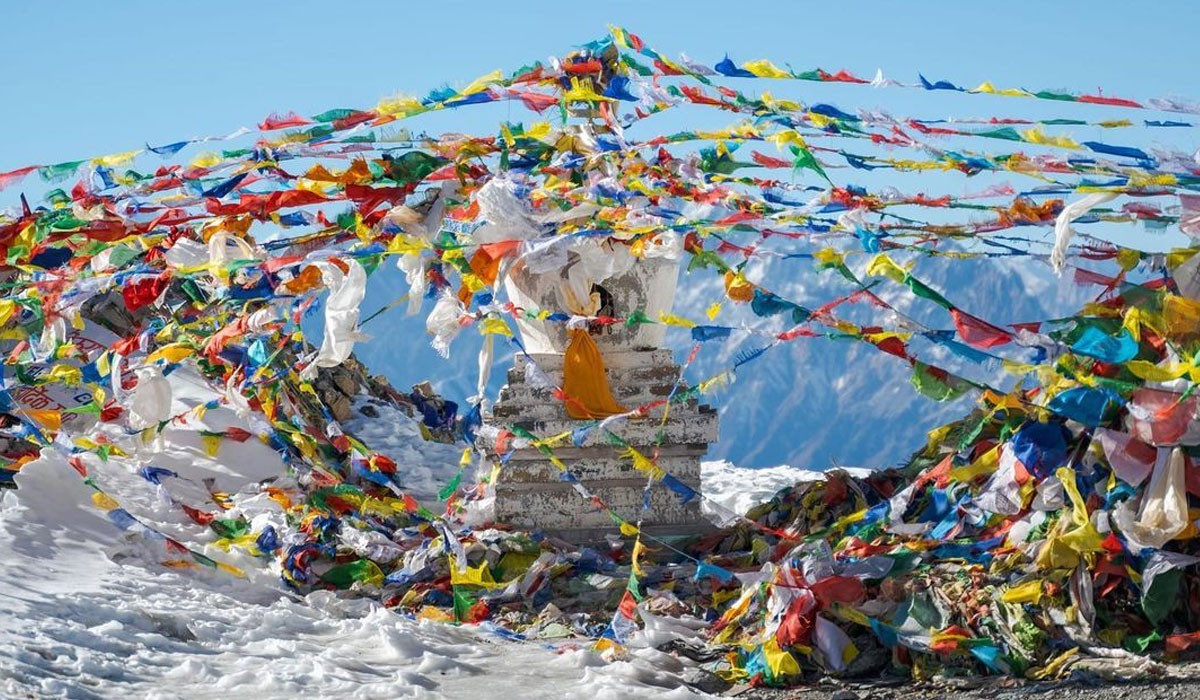
Compared to January, the climatic conditions are a little bit moderate during February. As the spring season is just at the doorstep, you might start seeing a few traces of the blooming season that slowly awakens the whole Himalayas.
This month adds a unique experience to your Himalayan exploration; you will get the opportunity to experience the true essence of the region at its peak and, at the same time, the fascinating cycle of nature that gradually introduces you to the stunning visuals of nature’s peak season. The day temperature of the Annapurna region at the lower trekking sections hovers around 8°C to 12°C and can drop up to -2°C to -14°C at the alpine altitudes.
Trek Duration
The general trek duration of Annapurna Circuit Trek is between 8 to 22 days; the itinerary plans of the package may differ depending on the highlight exploration, route, side detours, and acclimatization days. This iconic Himalayan expedition used to be a three-week exploration, however, thanks to the construction of the road on both sides of the circuit trekking route, the trek duration is now shorter and easily accessible.
Since 2015, the driving route in the Annapurna region stretches to Manang from the Besisahar side (eastern side) and all the way to Jomsom of the Kali Gandaki Valley (western side). Thus, now you can book the trekking packages that suit your taste and are within the timeframe of your vacation span.
Check our packages:
Difficulty Level of Annapurna Circuit
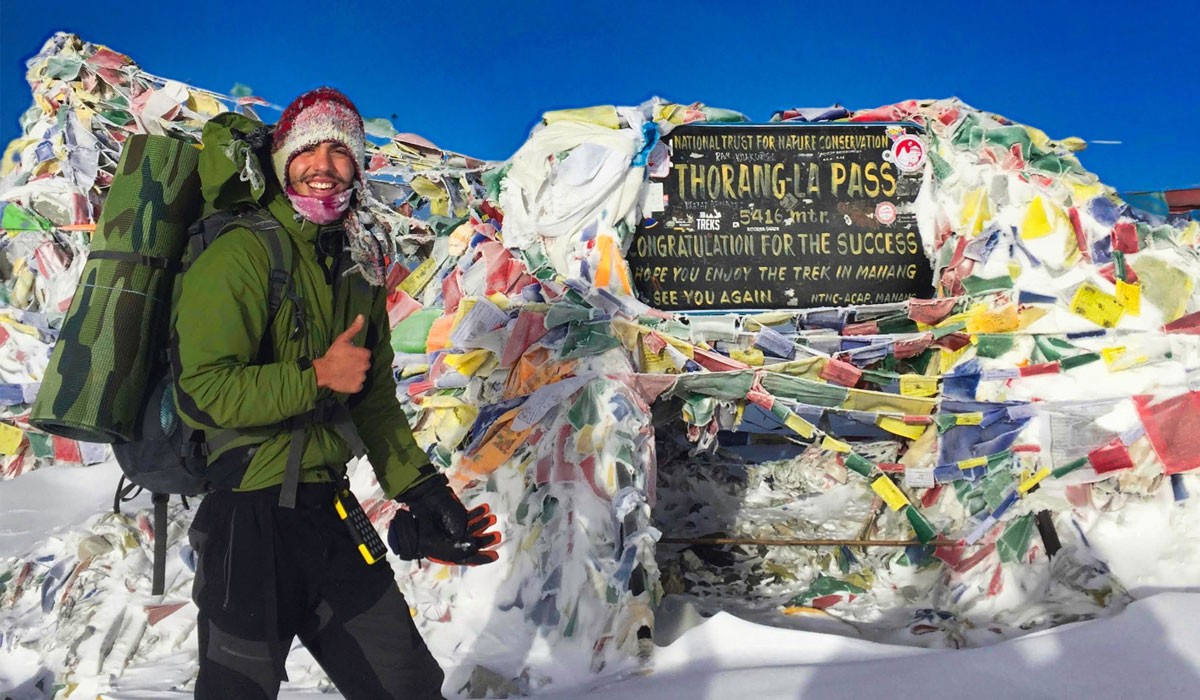
Annapurna Circuit Trek is one of the most iconic trekking adventures in the Himalayas that you have to try at least once in your lifetime. In case you are wondering about the difficulty level of this epic Himalayan exploration, it is just a ‘moderate’ level. You don’t need to have any prior Himalayan trekking experience or need to acquire any kind of technical skills to do this trek.
This amazing Himalayan exploration is perfect for even beginners who are new to the trekking game; however, you will still need to put in some effort to make the experience comfortable. Regardless of the moderate difficulty level, the Annapurna Circuit Trek is still a Himalayan exploration, and you have to overcome several challenging factors during your exploration, which is not easy to accomplish without enough preparation. Let's discuss some of the major hurdles in your Annapurna Circuit Trek during January and February that you have to overcome during your adventure.
Altitude Gain
Altitude gain is one of the major concerning factors in any kind of high-altitude adventure. It is hard for the human body to cope with an altitude above 2,500 meters due to the low oxygen saturation level. In your Annapurna Circuit Trek during January and February, you will traverse across significant altitudes of over 3,000 meters and 4,000 meters, so you will have to stay attentive toward any symptoms of altitude sickness.
Starting your adventure at Bhulbule (923 meters), you will move along the high elevation points like Lower Pisang (3,240 meters), Manang (3,540 meters), Yak Kharka (4,120 meters), Thorong Phedi (4,560 meters) and the highest elevation point of this adventure Thorung La pass (5,416 meters). So, you have to prepare adequately, stay hydrated, and pay attention to your body language to prevent altitude sickness.
Trekking Distance
The second hurdle of this beautiful exploration is the distance that you have to cover during your trekking adventure. The approximate trekking distance of the Annapurna Circuit Trek is approximately 160 km to 230 km, depending on the route and side excursion. So, during your trekking days, you will have to cover an approximate distance of 6-7 hours of walking on average.
It may not seem like a big deal at first; however, trekking for long hours at rising altitudes can be demanding and exhausting due to thin air. If you are not well-prepared for the long hours of walking, you may end up dragging yourself from one trekking point to another without actually enjoying the experience.
Remoteness
Yes, the Annapurna circuit is the second most popular trekking Himalayan trekking destination, but many forget to take into account that it is still a Himalayan exploration. This means you will be traversing across the remote part of the Himalayas, where the transportation facilities, infrastructural, and technological aspects are not well developed. So, if you're expecting anything like your regular vacation getaways, then you might end up getting disappointed.
Although you will be able to enjoy a moderate to grand level of services in this mainstream trekking route, they might not be on par with the top-tier services of an urban exotic tourist hub. So, you have to mentally prepare yourself that this exploration is about re-connecting with nature away from bustling life and not a luxurious cruise.
Acclimatization
If you have done any high-altitude adventure before, then you understand the importance of acclimatization in your exploration. It is recommended that when doing a high-altitude adventure, you should only gain up to 500 meters of altitude during a single day, and after overcoming over 1,000 meters of altitude, you should have an acclimatizing day.
So, if your trekking package doesn’t have enough acclimatizing days, you might struggle with day-to-day adventure and put yourself at risk of altitude sickness. So, finding the most ideal package for this expedition is an absolute necessity for a comfortable, safe, and memorable adventure.
Is Annapurna Circuit Trek Right For Me?
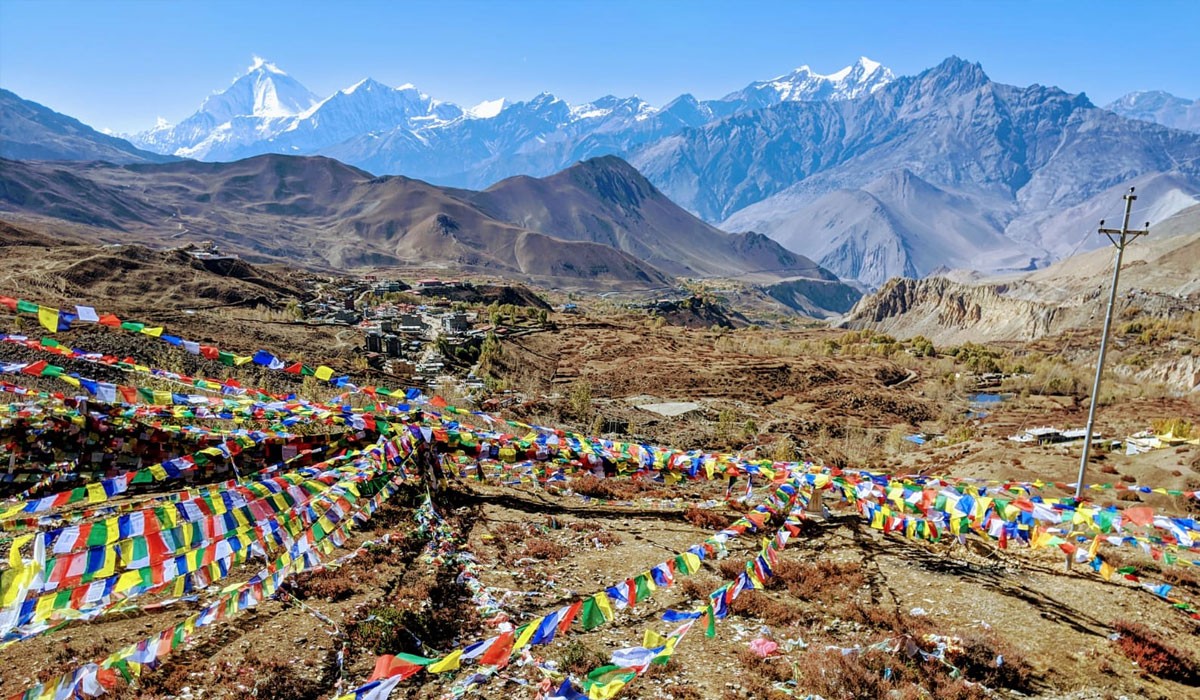
Considering the hurdles of the adventures, if you are wondering if this is the right adventure for you or not, rest assured. Even if you are a beginner, you can easily complete this Himalayan quest with enough preparation and determination. The difficulty factors of this expedition are relatively lower than other high altitude and remote exploration. Graded as a moderate Himalayan trekking adventure, the overall success rate of the Annapurna Circuit Trek is 98% to 100%.
So, if you have a basic level of fitness and good health conditions, you will be able to easily complete this expedition. Just don’t miss out on the preparation part and put some effort during your training to enjoy a comfortable experience. In case, you have any kind of health issues, you can consult your physician and trek guide for the trek.
Training and Preparation for Annapurna Circuit Trek During January and February

As Annapurna Circuit is a Himalayan adventure, you are recommended to prepare at least 4-6 weeks prior to your expedition. This way, your body will get enough time to get used to the physical activities. If you are an athlete or work out routinely, you may not need to put in a lot of hours during your training; however, if you don’t work out that much, then, you need to set an effective training program after assessing your physicality.
Doing practice hiking at steep landscapes is considered to be one of the most effective ways to prepare for the Annapurna Circuit Trek during January and February. As you have to overcome long hours of trekking, you are recommended to focus on strength, endurance, and cardiovascular exercises.
Strength and Endurance Exercises: Pull up, push up, plank, deadlift, squat, lunge, bicep curl, bench press,l overhead press, dips, etc.
Cardiovascular Exercises: Running, swimming, rowing, jogging, power walking, rope jumping, aerobics, etc.
Why Annapurna Circuit Trek During January and February?
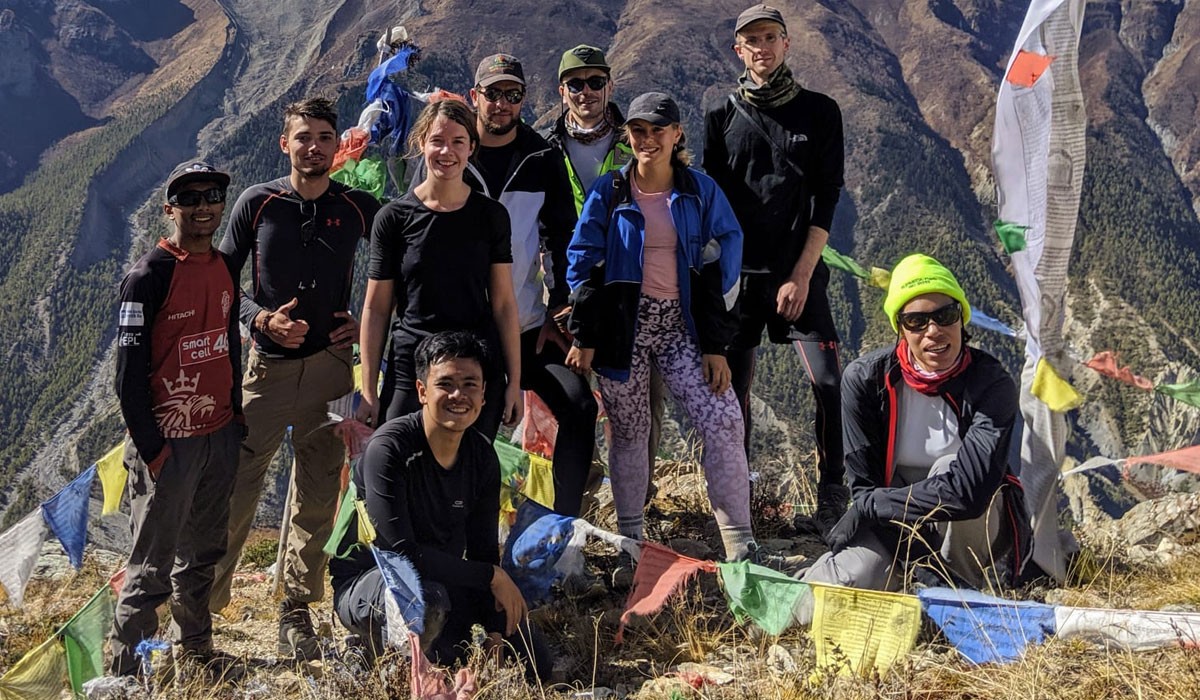
Magnificent Landscapes
The winter season is known as the peak season of the Himalayas doing the Annapurna Circuit Trek during January and February will offer you the most incredible views of the magnificent massifs at its peak. Even your higher trekking trails are covered in snow, so you will be able to enjoy the views of the pristine snow-clad landscapes that reflect the true magnificence of the Himalayan region.
Trekking amidst the surreal landscapes covered with the snow-clad blanket creates a picturesque setting that makes you feel like you have entered an enacted winter wonderland.
Clear Views
Although doing the Annapurna Circuit Trek during January and February may feel like you may not catch the incredible unobstructed views of the Himalayan vistas like the spring season, however, even if it is winter, the skies are often clear, and nothing like the skies covered with rain clouds in the monsoon season. So, even when trekking during these months, you will have the opportunity to enjoy the picturesque views of the wide, stunning vistas. The snow-clad terrains make the views of snow figurines even more magical as they reflect how truly magnificent the Himalayan region is.
Less Crowd
As these months are considered off-seasons, while doing the Annapurna Circuit during these months, you can expect less crowd on the trails. Many trekkers prefer exploring the Annapurna circuit during the peak seasons like autumn and spring. However, they often have to deal with the crowded trails and struggle with peaceful exploration.
However, if you choose January and February for this remarkable trekking adventure, the trekking routes are less crowded. Although, you will find some other true explorers like you along the trail who want to experience the magnificence of the Himalayan region at its pinnacle. It is nowhere near the crowded trekking trails of the peak season, so you can expect to enjoy a peaceful trekking route, immersed in the serene ambiance of the enthralling Himalayan region.
Festive Season
The winter season also invites a festive atmosphere in Nepal, this beautiful Himalayan country celebrates some of the fascinating and immersive festivals during January and February. So, if you are planning your Annapurna Circuit Trek during January and February, you will have the opportunity to add cultural prospects to your Himalayan exploration.
Maghe Sankranti, Saraswati Puja, Basanta Panchami, Losar, Tibetan New Year, Maha Shivaratri, and the festival of colors, Holi, are some of the grand festivals that are celebrated in Nepal during the winter season.
Cheaper Services
The winter and monsoon seasons in Nepal are considered the off-season when tourist activities are pretty low. So, while doing Annapurna Circuit Trek during January and February, you can expect the cost of the services and amenities to be pretty low. Unlike the surge of trekkers during the peak seasons, only a limited number of trekkers set out on the exploration of the Himalayan region, so besides the cost of services being low, you can also expect the teahouses to provide special offers and extra amenities.
For instance, in Annapurna Circuit Trek during January and February, some teahouses may provide extra blankets, free warm beverages, room heaters, etc, whereas your trekking agencies may offer your free trekking equipment like sleeping bags, heavy down jacket, and other kits to deal with the cold. So, not only will you enjoy trekking at lower costs, but you can also enjoy the free amenities to make your journey more comfortable.
Photography Opportunities
While doing Annapurna Circuit Trek during January and February, the unique lighting condition of the snow-clad terrain sets off the perfect conditions for striking photographic moments. The landscapes are covered with pristine snow, and the unique beauty of the settlements adorned with snow allows you to capture the incredible beauty of the winter perspective. Further, the magnificent frozen lakes of the region create an otherworldly atmosphere and add tranquility to the surrounding snow-clad landscapes.
Food and Accommodation on Annapurna Circuit Trek During January and February
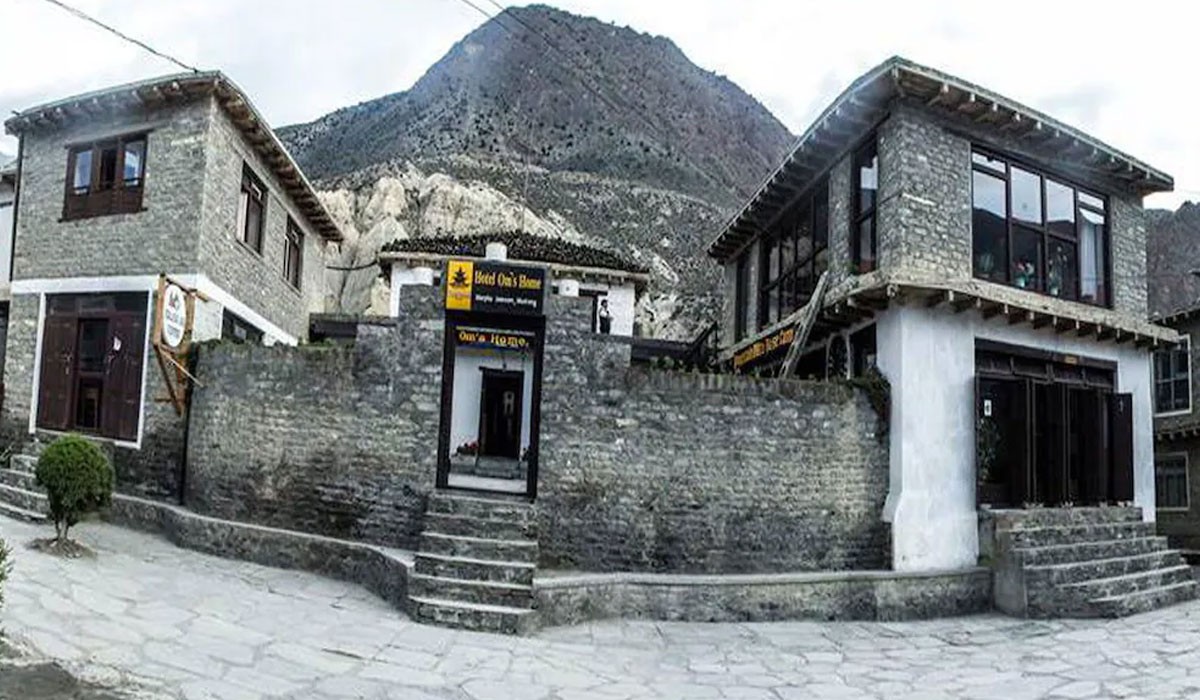
Annapurna Circuit is the second most popular trekking destination in the Himalayas; you can expect a wide range of delicacies to keep you warm during your exploration in January and February. You will be able to enjoy diverse delicacies that represent the whole nation, including the delicacies inspired by neighboring cultures like Indian and Tibetan.
For breakfast, you will be able to enjoy a light menu like bread and toast with jam, butter, or honey and other dishes like pancakes, cornflakes, oats, muesli, paratha, etc. As for lunch and dinner, the heavy traditional meal Dal Bhat Tarkari (steamed rice, lentil soup, and vegetable dishes) takes the first spot. You will also be able to savor other delicacies like momo, Chowmein, macarons, pizza, spaghetti, sandwiches, Thukpa, meat dishes, fries, burgers, etc.
Note: Vegetarian and vegan options are also available.
Accommodation
During your trekking adventure in the Annapurna region, you can enjoy moderate to luxury level of accommodation facilities. In a standard package, you will be accommodated in well-furnished rooms at the teahouses; there are two to three adjacent beds in a single room. The beds are equipped with comfortable mattresses and clean sheets; you will receive a pillow and warm blanket during your stay. The bathroom facilities are also on a shared basis in a standard package if you want a more personalized experience, then you can go for a luxury package.
